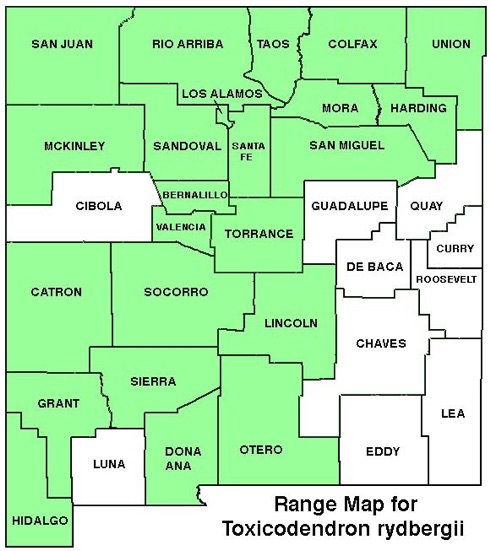WILDFLOWERS OF NEW MEXICO

“Leaflets three, leave it be!” goes the rule of thumb, and for a reason. This erect plant, 1–3 (up to 6) feet tall, single-stemmed or branching, and colony-forming, contains the toxic compound urushiol, which causes mild to severe skin rashes and eruptions if you are allergic to it. Clothes or pets that contact the plant can transfer the chemical to sensitive people. Note the leaves have three shiny, green leaflets; tiny, creamy flowers; and small, round fruit that birds devour and spread.
FLOWER: May–August. Dense, elongated clusters from leaf axils; flowers 1/8 inch long (3 mm), cream to greenish-yellow. Fruit small, 3/16 inch (5 mm), round drupes in clusters.
LEAVES: Alternate. Three leaflets on the end of a 5/8–10 inch long (1.5–25 cm) stalk (petiole). Leaflet blades oval, 1–4 inches long (3–10 cm), tip pointed, surfaces usually hairless, margins unevenly toothed. Leaves turn yellow, orange, and red in the fall.
HABITAT: Sandy, gravelly, loamy soils; riparian areas, drainages, canyons, fields, wet or dry meadows, disturbed areas; grasslands, pinyon-juniper-oak, ponderosa pine-Douglas-fir forests.
ELEVATION: 5,300–9,128 feet.
RANGE: AZ, CO, NM, NV, OK, TX; Rocky Mts., western and Great Lake states, east to Maine.
SIMILAR SPECIES: Eastern Poison Ivy, T. radicans, occurs in so. AZ and TX and eastward to the Atlantic coast, and is a climbing vine or subshrub with hairy aerial roots along the stem. Woodbine Creeper vine has 5 lance-shaped leaflets. Seedling Boxelder trees, Acer negundo, have 3–5 leaflets but the leaves are opposite. Fragrant Sumac, Rhus aromatica, statewide, is a 4 foot tall and wide shrub with red fruit.
NM COUNTIES: Most of NM except se plains in mid-to high-elevation, seasonally moist habitats: Bernalillo, Catron, Colfax, Dona Ana, Grant, Harding, Hidalgo, Lincoln, Los Alamos, McKinley, Mora, Otero, Rio Arriba, San Juan, San Miguel, Sierra, Socorro, Sandoval, Santa Fe, Taos, Torrance, Union, Valencia.









WESTERN POISON IVY
TOXICODENDRON RYDBERGII
Sumac Family, Anacardiaceae
Perennial subshrub, shrub



























THE CONTENTS OF THIS WEBSITE ARE COPYRIGHTED AND CANNOT BE USED
WITHOUT PERMISSION OF GEORGE OXFORD MILLER
















EMAIL ME



























Poison Ivy spreads by roots and can form large colonies.
The leaves turn bright colors in the fall.
Poison Ivy has three leaflets with irregular teeth. Remember “Leaflets three, let it be!”










Contact with poison ivy can cases serious skin dermatitis in sensitive people. The leaves, stem, and roots contain a potent oily irritant, urushiol. If poison ivy is burned, it can irritate the lungs. If exposed, wash with soap and water asap. Classic treatments include hot showers to relieve itching, application of calamine lotion or a steroid cream, and taking antihistamines such as Benadryl.
CDC photo







